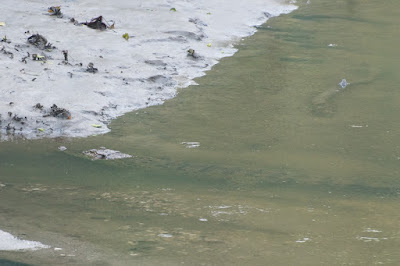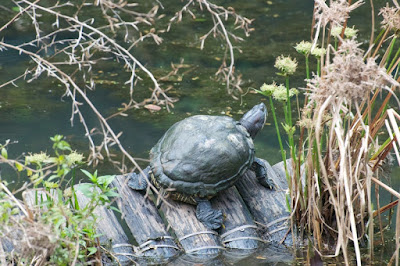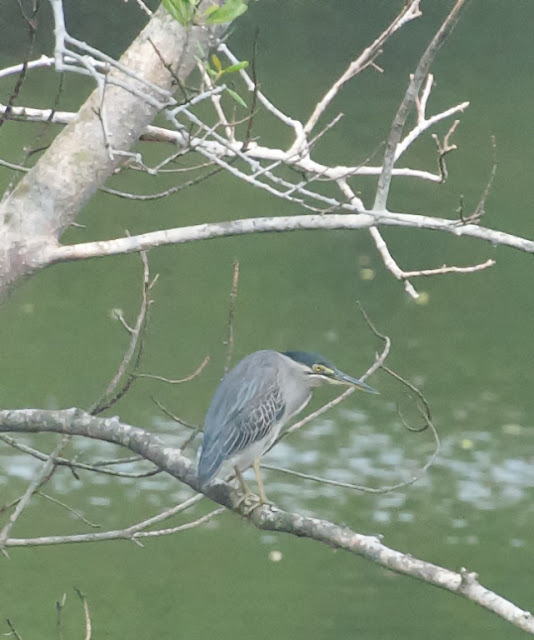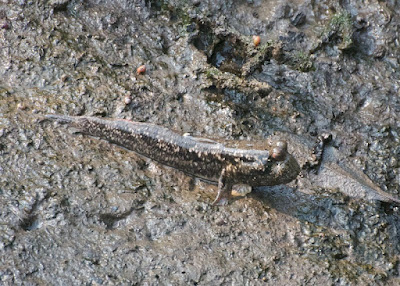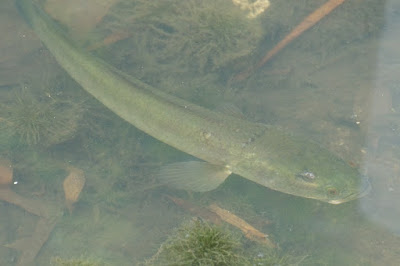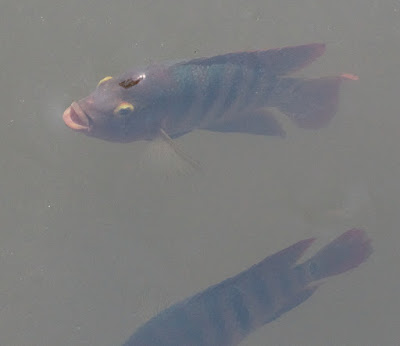Singapore is an island dominated by a city. It's so highly urbanized that it is hard to remember that it still has a few areas where wildlife still flourishes. One of them is the Sungei Buloh Wetland Reserve at the northern tip of the island, 202 hectares of mangrove forest full of creatures both large and small.
Over the course of our enforced stay in Singapore, where our grandson Royce was continuing his cancer treatment, our cousins the Changs had been promising a day at Sungei Buloh. The chance finally came on September 14, 2014, and I will tell you about it over the next two posts.
The trail from the reserve headquarters (which eventually becomes a boardwalk as the mud grows more glutinous) passes first through a lush coastal forest of mangroves and other trees, many decorated with epiphytic plants like this Birds' Nest Fern (Asplenium nidus).
The largest of the creatures we came across on our walk, by some considerable margin, was an Estuarine Crocodile (Crocodylus porosus). Crocodiles are listed as Critically Endangered in Singapore, and Sungei Buloh is one of the likeliest places to see one.
I have met a good many people who think they have seen crocodiles, but what they had actually seen was a Water Monitor (Varanus salvator).
Water Monitors, though somewhat crocodile-like (and certainly most likely to be seen swimming, crocodile-fashion), are of course lizards.
The Water Monitor is not a small animal, a fact that becomes more obvious when it leaves the water. It is, in fact, the third largest lizard in the world - though one Water Monitor apparently reached over three metres in length, making it the longest of the lot (the largest lizard alive today, the fabled Komodo Dragon (Varanus komodoensis), is much heavier, but not as long).
If you still think that the Water Monitor looks more like a crocodile (or, even worse, a dinosaur), these pictures should prove otherwise. Lizards and snakes have tongues like this, but not crocodiles and (presumably) not dinosaurs (at least based on their modern descendants the birds). After the monitor has picked up a bit of water on the tip of its tongue, it will transfer the sample to the chemically-sensitive Jacobson's organ in the roof of its mouth.
Red-eared Sliders (Trachemys scripta elegans) are not native to Singapore or anywhere else in Asia. They hail from the southeastern United States, and their presence at Sungei Buloh is a consequence of their having been, for many years, the turtle of choice for the international pet trade. Today, most of the turtles you can find in Singapore are not natives, but this species.
Water birds are of course a feature at Sungei Buloh. We found numbers of Common Redshanks (Tringa totanus), abundant winter visitors from the north.
We found this Striated Heron (Butorides striatus), a regular inhabitant of the mangroves, perched by the water's edge.
Storks have become a frequent sight at Sungei Buloh. The question is where they came from. These photos show two species: the Milky Stork (Mycteria cinerea), a rare Southeast Asian species [the bird preening itself at the left in the bottom photo] and the Painted Stork (Mycteria leucocephala), a bird whose range centres on India. The birds at Sungei Buloh are actually free-flying birds from the nearby Singapore Zoo and Jurong Bird Park, and unfortunately have a tendency to hybridize - not a good thing for either species.
Even with water lapping around the bases of its tree trunks, a mangrove forest provides plenty of habitat for land-based (or at least arboreal) creatures too. The beautiful little Scarlet-backed Flowerpecker (Dicaeum cruentatum) only needs a supply of fruits (in this case, apparently, a tiny fig) to sustain itself, in a mangrove forest or a city garden. This one, one of the objects of a long-term study of the reserve's birdlife, wears a metal leg band.
The ubiquitous Plantain Squirrel (Callosciurus notatus) also finds a home among the mangroves. I found these two apparently settling in for a midday nap.
A tree limb can also provide a napping post for a young Water Monitor.
Eventually, the trail through the mangrove forest emerges onto the mudflats at the edge of the Straits of Johor, where you can look across the water to the Malaysian city of Johor Bahru.
Here, at the interface between land and sea, is the home of the mudskippers, members of the goby family that hunt, fight and mate out of the water. We found two of Singapore's mudskippers here. This one is the Yellow-spotted mudskipper (Periophthalmus walailakae).
This is the common and oddly-attractive Blue-spotted Mudskipper (Boleophthalmus boddarti).
The Blue-spotted Mudskipper is a carnivore; this one appears to be homing in on a prawn.
Hunting the mudskippers in their turn is another denizen of the mudflats, the Dog-faced Water Snake (Cerberus scchneiderii).
The snakes hide in burrows in the mud as well as crawling over it. This one is waiting in its burrow, only its head showing.
A bit further along, the boardwalk crosses open brackish water, home to fishes that cannot scamper over the mudflats as mudskippers do. The Common Snakehead (Channa striata) is a popular Asian food fish, but in North America (where they have been accidentally introduced) snakeheads (of a related species) have been regarded as something of a plague: voracious monsters devouring everything local in their path, or something like that.
The Mayan Cichlid (Cichlosoma urophthalmus), on the other hand, is a North (or rather Central) American fish that has been released in Singapore waters, probably as an escapee from the aquarium trade.
Mudskippers are odd enough, but some of the other mangrove fishes have their own peculiarities. The Stripe-nosed Halfbeak (Zenarchopterus buffonis), like all halfbeaks, has a most unusual set of jaws. The lower jaw of halfbeaks protrudes to form what ought to be a long beak, as in their cousins the needlefishes, but the upper jaw (as this photo shows rather well) is of normal length, as in their other cousins the flyingfishes. This peculiar arrangement apparently helps the fishes scoop fallen insects from the surface of the water, though I confess I can't see how.
The Banded Archerfish (Toxotes jaculatrix) is an insect-eater too but it doesn't wait for its prey to fall into the water. Instead, it uses its tongue, held against a groove on the roof of its mouth, to form a tube through which it spits a stream of water with the accuracy of an expert blowgun hunter. Its force is enough to knock its prey from a height of over a metre into the waters below. I have yet to see one actually perform this feat (I missed doing so once by a few seconds), but seeing archerfishes, knowing what they can do, is remarkable enough.



